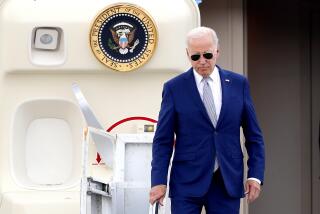Thousands greet Obama in historic Myanmar visit
- Share via
YANGON, Myanmar -- President Obama was greeted by thousands of people here Monday, a sea of smiling faces and tiny American flags filling the streets in a place where even small public gatherings once caused government suspicion.
But it was the U.S. president who was laying out the welcome mat.
Obama flew to Myanmar as a gesture to symbolically welcome the long-isolated Southeast Asian nation back to the international fold. After decades of harsh authoritarian rule, the government’s recent steps toward democratic reforms -- epitomized by its release in 2010 of iconic dissident Aung San Suu Kyi -- earned it its first U.S. presidential visit, along with a fresh cache of aid and other support.
But Obama also stands to benefit from Myanmar’s early successes. Its recent shift toward democratic reforms is thus far a success story for his policy of engaging nations that the previous administration had shunned. The policy has yielded few results elsewhere, and the president did not waste the opportunity to share in the credit -- and issue a fresh overture.
“I want to send a message across Asia: We don’t need to be defined by the prisons of the past. We need to look forward to the future,” Obama said in a speech capping his six-hour visit.
The trip was designed as the emotional highlight of a four-day Asian tour that also includes stops in Thailand and Cambodia.
The visit was packed with local symbolism. Obama spoke at Yangon University, once a hot bed of student revolutions that after two decades of neglect has deteriorated into a shell of its former self. The government has recently agreed to reinvest in the school.
His motorcade was greeted by thousands of children, dressed in a uniform of deep green longyi sarongs and white shirts, lining the road from the airport.
Meeting with President Thein Sein, whose government has undertaken the recent reforms, Obama offered a gesture of goodwill, calling the country Myanmar -- the name the chosen by the military regime after it crushed a democratic movement in 1988, rather than Burma, the name preferred by opposition leaders.
After his speech, Obama visited with Suu Kyi at the lakeside home where she spent most of the past two decades in detention and separated from her family for her opposition to the regime.
The lush grounds were surrounded by a high razor-wire fence and spruced up with freshly planted rose bushes. Suu Kyi, known to supporters as “The Lady,” met the president with a bow and a smile, but saved an embrace for Secretary of State Hillary Rodham Clinton, who is traveling with the president on her last foreign trip. Clinton made her own pilgrimage to Suu Kyi’s home last year.
In her remarks after their private meeting, Suu Kyi warned of being “lured by a mirage of success” and vowed to continue to push for reform.
Obama also has been careful not to appear to be taking a victory lap, instead urging continue progress in the country.
In his remarks, the president bluntly challenged Myanmar to be more inclusive and pressured Thein Sein’s government to address ethnic divisions that continue to cause violence and discrimination.
His speech at times sounded like a civics lesson, explaining the importance of checks and balances in government and respect for civil rights, but he also made a personal connection.
“I stand before you today as president of the most powerful nation on Earth, but recognizing that once the color of my skin would have denied me the right to vote,” he said, with Suu Kyi and Clinton listening from the audience. “And so that should give you some sense that if our country can transcend its differences, then yours can too.”
ALSO:
Israeli strikes hurt Gaza journalists as cease-fire talks falter
Obama lands in Thailand even as Gaza crisis draws his attention
Must Reads: Gaza attacks, an Afghan bakery and a Beijing debut
More to Read
Sign up for Essential California
The most important California stories and recommendations in your inbox every morning.
You may occasionally receive promotional content from the Los Angeles Times.










